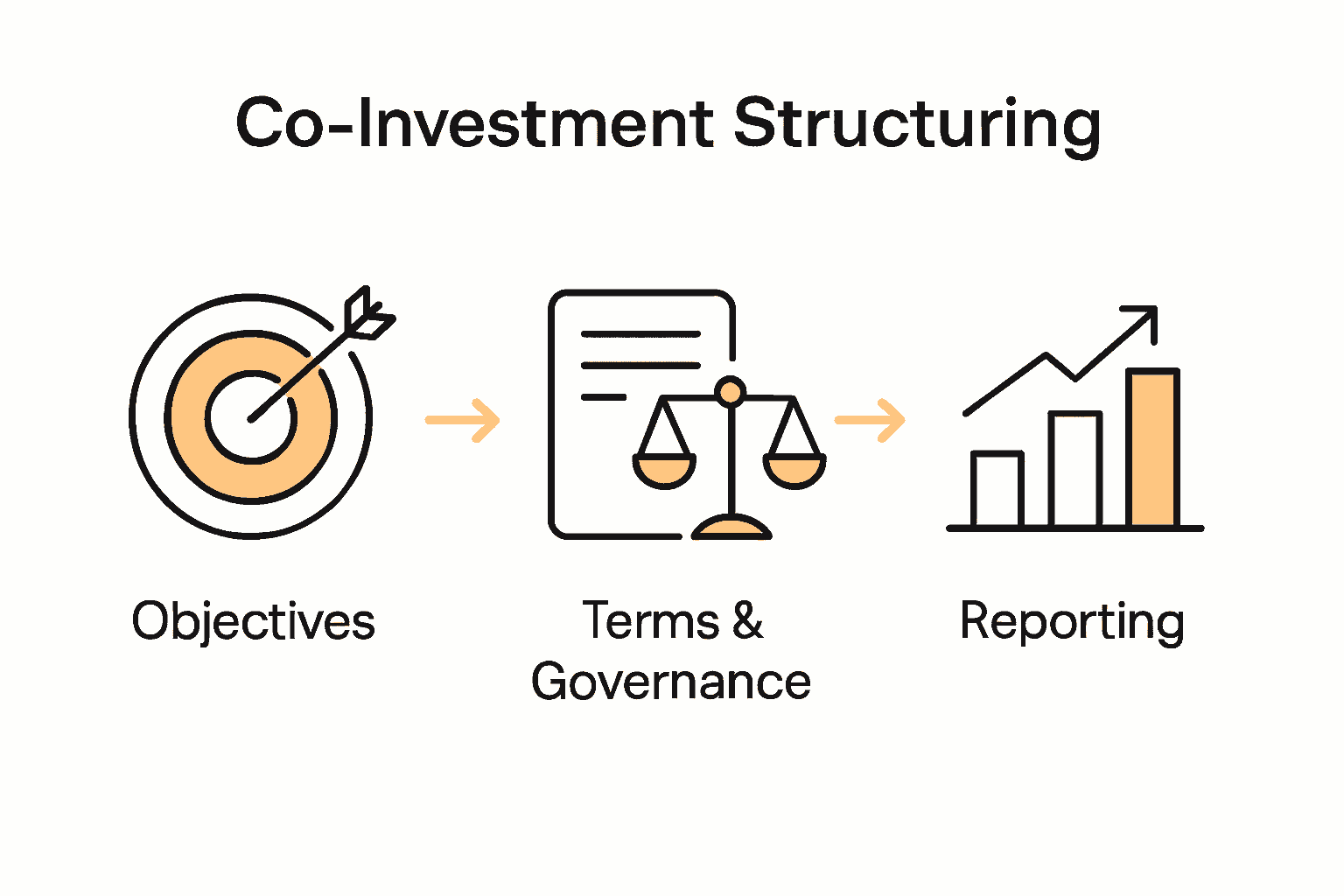Over half of american family offices are now considering co-investments to support long-term financial goals while managing complex risks. With wealth preservation and intergenerational planning at stake, the right framework determines whether collaboration leads to growth or unnecessary exposure. This guide shares clear strategies for aligning objectives, assessing risk, and establishing processes designed for the specific needs of american investors seeking strong and secure co-investment partnerships.
Table of Contents
- Step 1: Assess Strategic Objectives And Risk Profiles
- Step 2: Formulate Co-Investment Terms And Governance
- Step 3: Execute Due Diligence And Legal Documentation
- Step 4: Implement Reporting And Communication Protocols
- Step 5: Evaluate Performance And Ongoing Alignment
Quick Summary
| Key Insight | Explanation |
|---|---|
| 1. Define Core Investment Objectives | Clearly outline goals like wealth preservation and risk mitigation to guide strategic investments. |
| 2. Develop Comprehensive Governance Framework | Create clear terms outlining responsibilities and decision-making to ensure fairness among partners. |
| 3. Execute Thorough Due Diligence | Conduct in-depth analysis of financials and legal standings to minimize risks in potential investments. |
| 4. Establish Robust Reporting Protocols | Implement standardized financial reporting and communication channels to maintain transparency and trust. |
| 5. Continuously Evaluate Performance | Regularly assess investment outcomes and strategic alignment to adapt to market changes and enhance collaboration. |

Step 1: Assess Strategic Objectives and Risk Profiles
Successfully structuring co investments for family offices requires a comprehensive understanding of strategic objectives and nuanced risk assessment. Mercer recommends adopting a total portfolio approach that enables coordinated investment strategies focused on optimizing diversification and risk management.
To effectively assess strategic objectives, family offices must first clearly define their core investment priorities. WMI highlights the importance of identifying specific goals like wealth preservation, intergenerational transfer, and strategic risk mitigation. This process involves a detailed examination of your family office’s long term financial vision, including considerations such as investment time horizons, liquidity requirements, and tolerance for potential market volatility.
When evaluating risk profiles, analyze historical performance metrics, current market conditions, and potential future economic scenarios. Create a comprehensive risk assessment framework that categorizes potential investments across different risk categories ranging from conservative to aggressive. Pay close attention to correlation between different asset classes and how proposed co investments align with your overall portfolio strategy. A strategic and methodical approach ensures that each potential co investment contributes meaningfully to your family office’s broader financial objectives while maintaining an appropriate risk balance.
Step 2: Formulate Co-Investment Terms and Governance
Successfully structuring co-investments requires meticulously designed terms and robust governance frameworks that protect all participating parties. When developing these critical agreements, family offices must create comprehensive documents that clearly outline investment parameters, decision making protocols, and shared responsibilities.
The governance framework should establish precise mechanisms for collaboration, including specific guidelines around capital contributions, investment allocation, performance monitoring, and exit strategies. You will want to develop detailed term sheets that address key aspects such as equity ownership percentages, profit distribution models, voting rights, and dispute resolution processes. How to Structure Family Governance provides excellent insights into creating transparent and effective governance structures.
Critical elements to include in your co-investment terms involve defining clear communication channels, establishing periodic review mechanisms, and creating transparent reporting requirements. Consider developing a shared investment committee with representatives from all participating family offices to ensure balanced decision making and aligned strategic objectives. Pay special attention to potential conflicts of interest, confidentiality provisions, and mechanisms for managing unexpected changes in investment conditions. By crafting comprehensive and flexible governance frameworks, you can create a solid foundation for successful collaborative investments that protect the interests of all stakeholders.

Step 3: Execute Due Diligence and Legal Documentation
Executing comprehensive due diligence and preparing meticulous legal documentation are critical steps in structuring successful co-investments for family offices. This phase requires a systematic approach to investigating potential investment opportunities, assessing risks, and creating legally binding agreements that protect all parties involved.
The due diligence process demands a thorough examination of multiple dimensions, including financial performance, legal standing, operational capabilities, and strategic alignment. Engage specialized legal and financial experts who can conduct deep forensic analysis of target investments, examining financial statements, corporate governance structures, regulatory compliance, and potential hidden liabilities. Master Your Estate Planning Workflow offers valuable insights into creating robust documentation processes that can be adapted to co-investment contexts.
When preparing legal documentation, prioritize creating comprehensive agreements that clearly define each party’s rights, obligations, and potential exit strategies. Develop detailed term sheets that address potential scenarios including performance underperformance, dispute resolution mechanisms, capital contribution requirements, and profit distribution frameworks. Ensure all legal documents undergo rigorous review by independent legal counsel representing each family office to guarantee fairness and minimize potential future conflicts. By approaching due diligence and legal documentation with methodical precision, you establish a solid foundation for collaborative investments that can withstand complex financial and operational challenges.
Step 4: Implement Reporting and Communication Protocols
Establishing robust reporting and communication protocols is essential for maintaining transparency and alignment in co-investment partnerships among family offices. This critical step ensures all participating parties have clear visibility into investment performance, strategic decisions, and potential challenges.
Cambridge Associates emphasizes the importance of developing a comprehensive investment governance framework that prioritizes transparent communication channels. Your reporting protocols should include standardized financial reporting templates, regular investment performance updates, detailed quarterly and annual reviews, and real time access to key performance indicators for all stakeholders.
Design a communication infrastructure that facilitates seamless information exchange while protecting confidentiality. Implement secure digital platforms that enable encrypted sharing of sensitive financial documents, establish predetermined communication frequencies for different types of updates, and create a clear escalation process for addressing unexpected investment developments. Consider establishing a centralized dashboard that provides consolidated views of investment performance, risk metrics, and strategic insights. By creating a systematic and transparent communication framework, you will build trust among co-investment partners and enable more effective collaborative decision making across your family office network.
Step 5: Evaluate Performance and Ongoing Alignment
Continuous performance evaluation is critical for maintaining the strategic integrity of co-investment partnerships among family offices. This step involves developing a systematic approach to tracking investment outcomes, assessing strategic alignment, and making data driven adjustments to your collaborative investment strategy.
Family Office emphasizes the importance of implementing a robust governance framework that facilitates ongoing alignment with your family’s core objectives and values. Develop a comprehensive performance evaluation methodology that includes quantitative metrics such as return on investment, risk adjusted performance, and comparative benchmarking, alongside qualitative assessments of strategic fit and long term potential.
To optimize your ongoing evaluation process, How to Optimize Family Office Operations suggests creating a dynamic assessment framework that goes beyond traditional financial metrics. Implement periodic strategic review meetings, develop early warning indicators for potential performance deviations, and establish clear mechanisms for collaborative decision making when adjustments are necessary. Your evaluation process should be flexible enough to accommodate changing market conditions while maintaining a consistent approach to performance measurement and strategic alignment across all co-investment partnerships.
Streamline Your Family Office Co-Investment Strategy with Future Family Office
Structuring co-investments for family offices involves complex challenges from strategic risk assessment to governance and transparent reporting. If you are aiming to clarify your investment objectives while ensuring solid legal frameworks and ongoing performance evaluation you understand the urgency of accessing trusted resources and expert connections. At Future Family Office you will find a dedicated platform crafted to demystify the private wealth management sector and empower you with tailored insights and networking opportunities.
Discover how our comprehensive directory and expert articles can support your family office in:
- Defining clear investment priorities aligned with your long-term vision
- Establishing robust governance and communication protocols
- Accessing vetted service providers and industry thought leadership

Take control of your co-investment journey today and join a vibrant community committed to transparency and collaboration. Visit Future Family Office now to explore practical solutions that align with the strategic rigor outlined in “How to Structure Co-Investments for Family Offices” and transform your investment challenges into growth opportunities.
Frequently Asked Questions
What are the key strategic objectives to consider when structuring co-investments for family offices?
To effectively structure co-investments, family offices should evaluate key objectives such as wealth preservation, intergenerational transfer, and risk mitigation. Clearly define these priorities to align investment strategies with your long-term financial vision.
How can I assess the risk profile of potential co-investments?
Assessing the risk profile involves analyzing historical performance, current market conditions, and developing a comprehensive risk assessment framework. Categorize potential investments as conservative or aggressive and ensure they align with your overall portfolio strategy.
What should be included in co-investment terms and governance documents?
Co-investment agreements should include clear investment parameters, decision-making protocols, and guidelines for capital contributions and profit distribution. Develop detailed term sheets to cover equity ownership, voting rights, and dispute resolution processes to protect all parties involved.
What steps should be taken to execute due diligence for co-investments?
Conduct thorough due diligence by examining financial performance, legal standings, and operational capabilities of target investments. Engage legal and financial experts to perform forensic analyses to uncover any potential hidden liabilities and risks.
How can family offices establish effective reporting and communication protocols in co-investments?
Implement robust reporting protocols that include standardized financial updates and clear communication channels among partners. Consider creating a centralized dashboard for real-time access to investment performance and facilitate periodic review meetings to ensure transparency and trust.
What metrics should be used to evaluate the performance of co-investments?
Use a combination of quantitative metrics like return on investment and risk-adjusted performance, along with qualitative assessments of strategic fit. Regularly assess these metrics and be ready to make data-driven adjustments to maintain alignment with your family office’s objectives.
Recommended
- How To Build A Family Office Deal Flow Pipeline – Future Family Office
- 6 Tips To Get Family Offices Started With Impact Investing – Future Family Office
- 3 Tips To Effectively Connect And Raise Investment From Family Offices. – Future Family Office
- Understanding Family Office Structure Explained in Detail – Future Family Office




